Healthcare Policy and Economics: Nurse's Role, ACA, and Advocacy
VerifiedAdded on 2023/01/16
|9
|2499
|1
Essay
AI Summary
This essay examines the crucial role of nurses in healthcare policy and economics, with a particular focus on the Affordable Care Act (ACA) and patient advocacy. The introduction highlights the ACA's goals of increasing access, consumer protections, and improving healthcare quality, while also emphasizing the nurse's pivotal role in both policy implementation and patient care. The essay delves into how nurses, as frontline healthcare providers, are essential in promoting health, preventing illness, and advocating for patients' rights, as defined by the American Nurses Association (ANA). It explores how adherence to the ACA and patient advocacy ethics fosters safer and improved healthcare services, reducing risks such as medication errors and negligence. The essay further discusses the nurse's role in patient advocacy, including assessing patient needs, establishing therapeutic relationships, and implementing care plans based on patient decisions. Finally, it analyzes how the ACA and evolving healthcare policies are reshaping the nursing profession, creating new opportunities for advanced practice, increased responsibilities, and the need for continuous professional development to meet the changing demands of the healthcare landscape. The essay concludes by emphasizing the profound impact of the ACA and patient advocacy on nurses, patients, and the healthcare system, ensuring better, more equitable, and risk-free healthcare delivery.
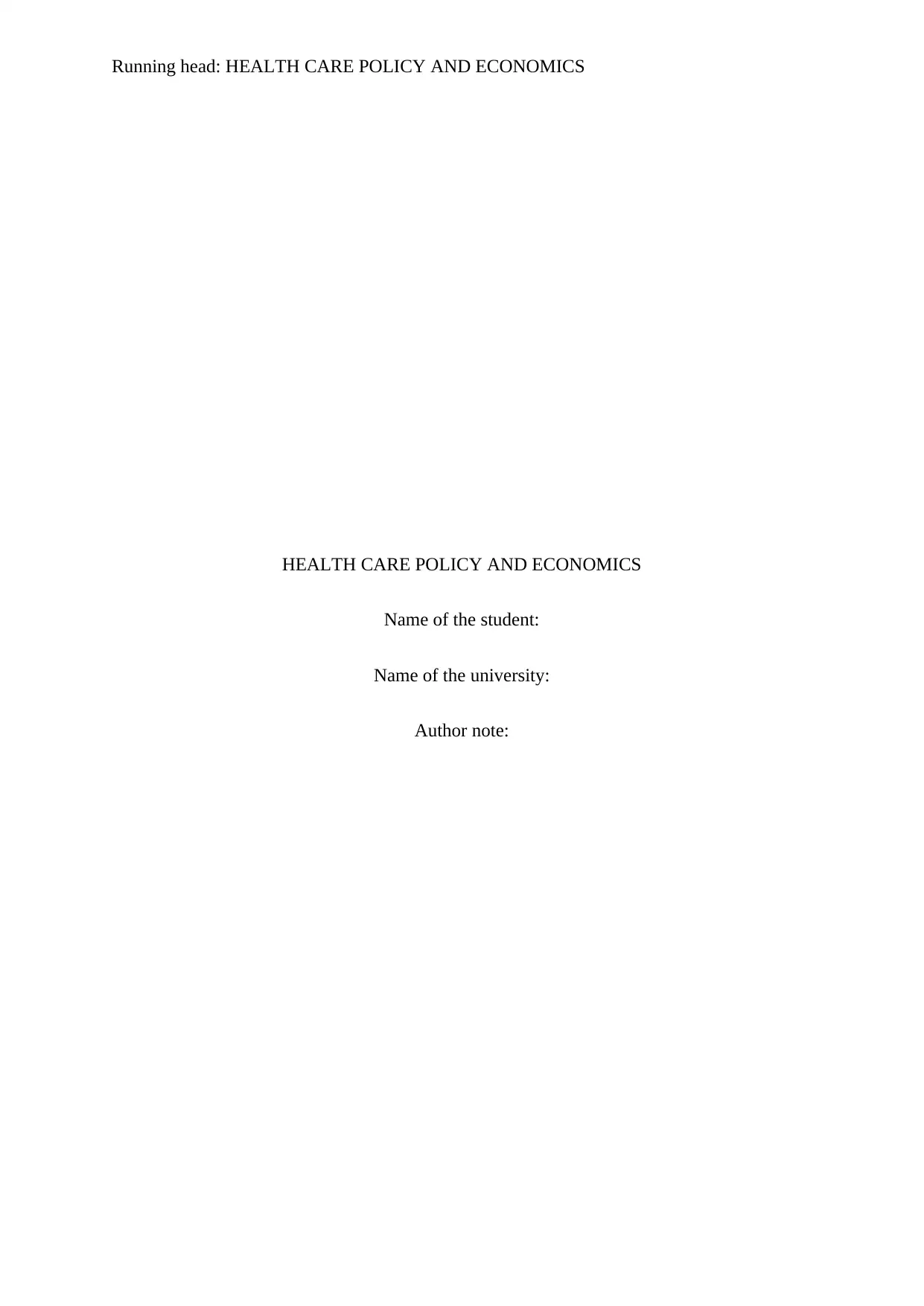
Running head: HEALTH CARE POLICY AND ECONOMICS
HEALTH CARE POLICY AND ECONOMICS
Name of the student:
Name of the university:
Author note:
HEALTH CARE POLICY AND ECONOMICS
Name of the student:
Name of the university:
Author note:
Paraphrase This Document
Need a fresh take? Get an instant paraphrase of this document with our AI Paraphraser
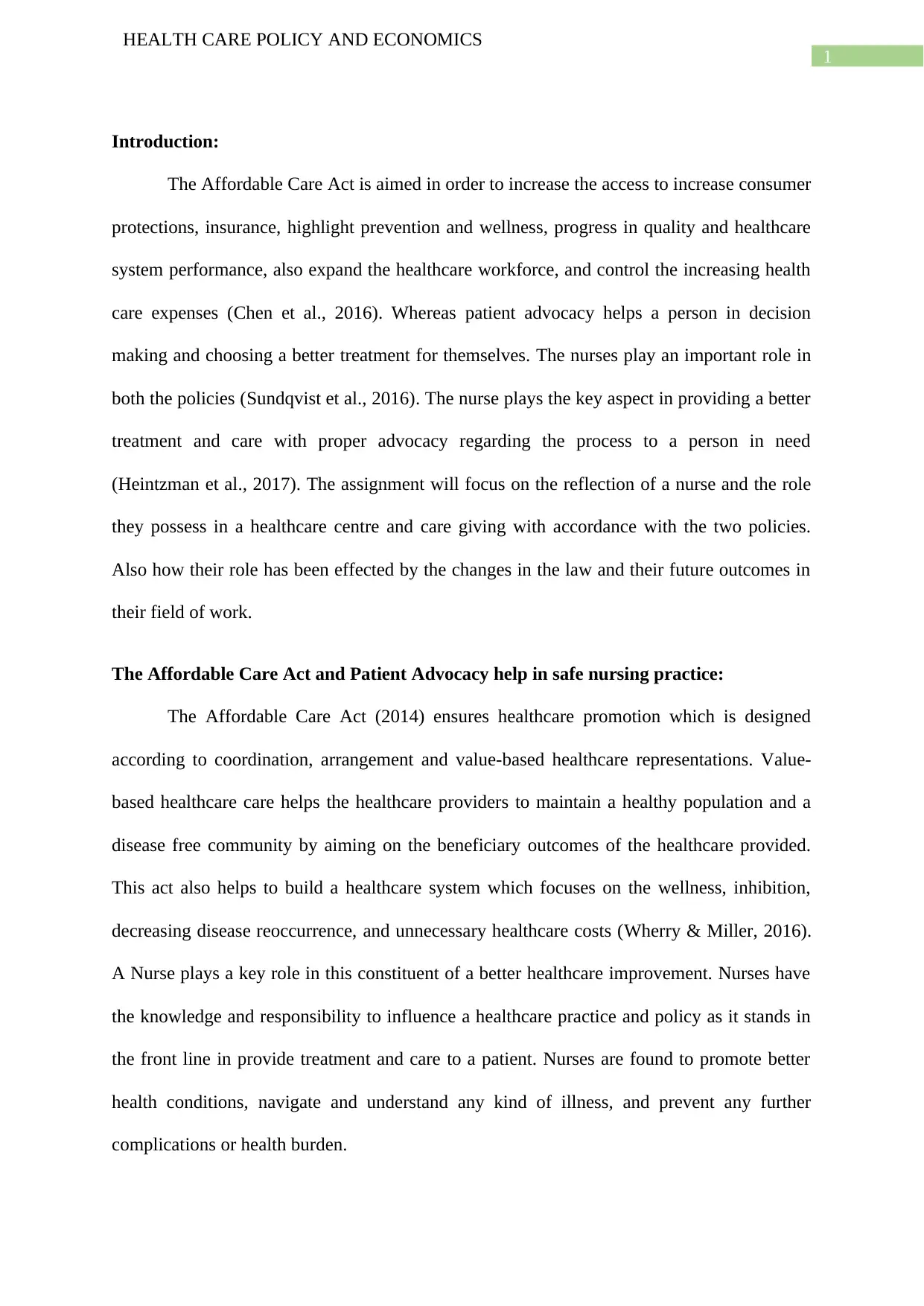
1
HEALTH CARE POLICY AND ECONOMICS
Introduction:
The Affordable Care Act is aimed in order to increase the access to increase consumer
protections, insurance, highlight prevention and wellness, progress in quality and healthcare
system performance, also expand the healthcare workforce, and control the increasing health
care expenses (Chen et al., 2016). Whereas patient advocacy helps a person in decision
making and choosing a better treatment for themselves. The nurses play an important role in
both the policies (Sundqvist et al., 2016). The nurse plays the key aspect in providing a better
treatment and care with proper advocacy regarding the process to a person in need
(Heintzman et al., 2017). The assignment will focus on the reflection of a nurse and the role
they possess in a healthcare centre and care giving with accordance with the two policies.
Also how their role has been effected by the changes in the law and their future outcomes in
their field of work.
The Affordable Care Act and Patient Advocacy help in safe nursing practice:
The Affordable Care Act (2014) ensures healthcare promotion which is designed
according to coordination, arrangement and value-based healthcare representations. Value-
based healthcare care helps the healthcare providers to maintain a healthy population and a
disease free community by aiming on the beneficiary outcomes of the healthcare provided.
This act also helps to build a healthcare system which focuses on the wellness, inhibition,
decreasing disease reoccurrence, and unnecessary healthcare costs (Wherry & Miller, 2016).
A Nurse plays a key role in this constituent of a better healthcare improvement. Nurses have
the knowledge and responsibility to influence a healthcare practice and policy as it stands in
the front line in provide treatment and care to a patient. Nurses are found to promote better
health conditions, navigate and understand any kind of illness, and prevent any further
complications or health burden.
HEALTH CARE POLICY AND ECONOMICS
Introduction:
The Affordable Care Act is aimed in order to increase the access to increase consumer
protections, insurance, highlight prevention and wellness, progress in quality and healthcare
system performance, also expand the healthcare workforce, and control the increasing health
care expenses (Chen et al., 2016). Whereas patient advocacy helps a person in decision
making and choosing a better treatment for themselves. The nurses play an important role in
both the policies (Sundqvist et al., 2016). The nurse plays the key aspect in providing a better
treatment and care with proper advocacy regarding the process to a person in need
(Heintzman et al., 2017). The assignment will focus on the reflection of a nurse and the role
they possess in a healthcare centre and care giving with accordance with the two policies.
Also how their role has been effected by the changes in the law and their future outcomes in
their field of work.
The Affordable Care Act and Patient Advocacy help in safe nursing practice:
The Affordable Care Act (2014) ensures healthcare promotion which is designed
according to coordination, arrangement and value-based healthcare representations. Value-
based healthcare care helps the healthcare providers to maintain a healthy population and a
disease free community by aiming on the beneficiary outcomes of the healthcare provided.
This act also helps to build a healthcare system which focuses on the wellness, inhibition,
decreasing disease reoccurrence, and unnecessary healthcare costs (Wherry & Miller, 2016).
A Nurse plays a key role in this constituent of a better healthcare improvement. Nurses have
the knowledge and responsibility to influence a healthcare practice and policy as it stands in
the front line in provide treatment and care to a patient. Nurses are found to promote better
health conditions, navigate and understand any kind of illness, and prevent any further
complications or health burden.
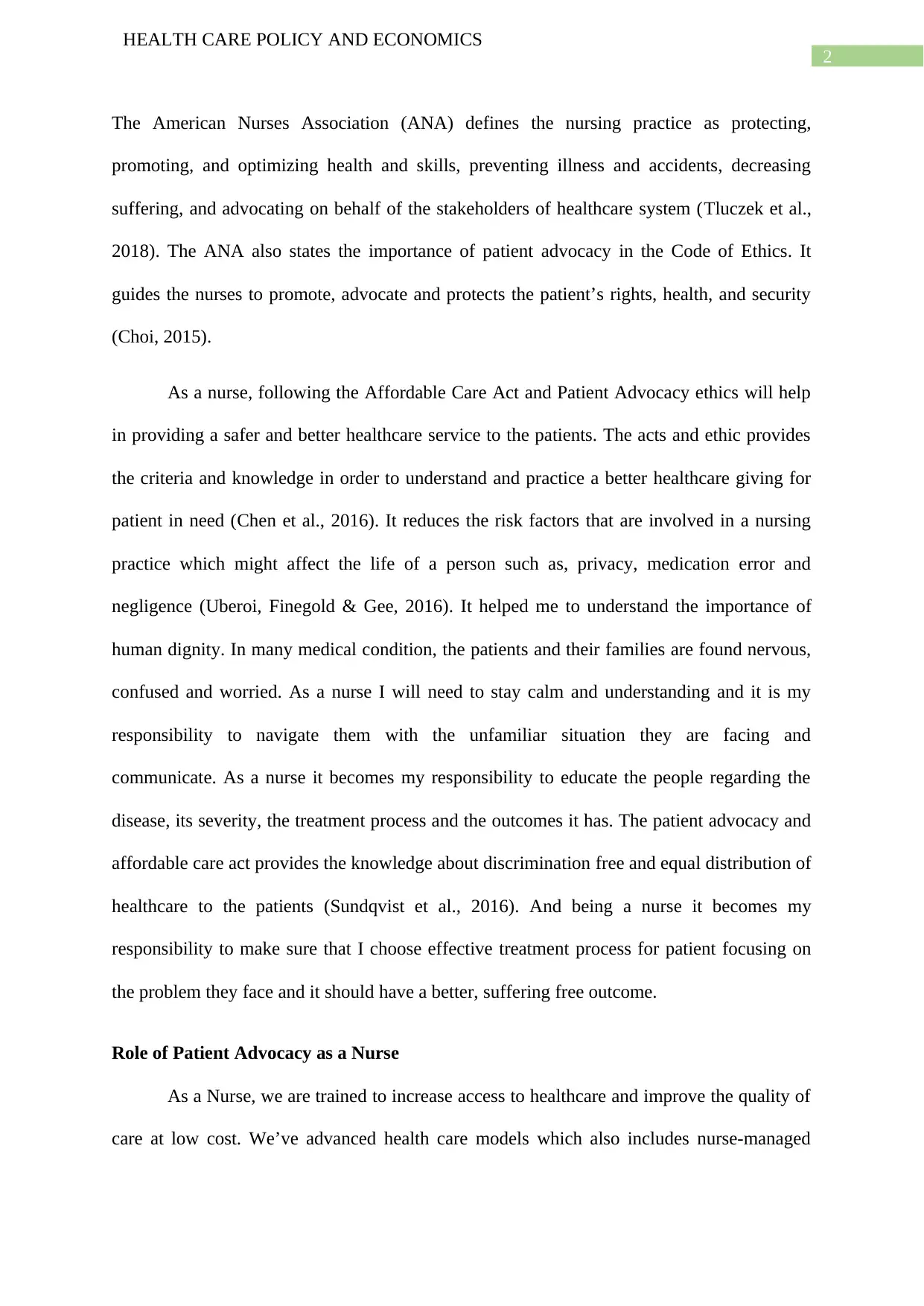
2
HEALTH CARE POLICY AND ECONOMICS
The American Nurses Association (ANA) defines the nursing practice as protecting,
promoting, and optimizing health and skills, preventing illness and accidents, decreasing
suffering, and advocating on behalf of the stakeholders of healthcare system (Tluczek et al.,
2018). The ANA also states the importance of patient advocacy in the Code of Ethics. It
guides the nurses to promote, advocate and protects the patient’s rights, health, and security
(Choi, 2015).
As a nurse, following the Affordable Care Act and Patient Advocacy ethics will help
in providing a safer and better healthcare service to the patients. The acts and ethic provides
the criteria and knowledge in order to understand and practice a better healthcare giving for
patient in need (Chen et al., 2016). It reduces the risk factors that are involved in a nursing
practice which might affect the life of a person such as, privacy, medication error and
negligence (Uberoi, Finegold & Gee, 2016). It helped me to understand the importance of
human dignity. In many medical condition, the patients and their families are found nervous,
confused and worried. As a nurse I will need to stay calm and understanding and it is my
responsibility to navigate them with the unfamiliar situation they are facing and
communicate. As a nurse it becomes my responsibility to educate the people regarding the
disease, its severity, the treatment process and the outcomes it has. The patient advocacy and
affordable care act provides the knowledge about discrimination free and equal distribution of
healthcare to the patients (Sundqvist et al., 2016). And being a nurse it becomes my
responsibility to make sure that I choose effective treatment process for patient focusing on
the problem they face and it should have a better, suffering free outcome.
Role of Patient Advocacy as a Nurse
As a Nurse, we are trained to increase access to healthcare and improve the quality of
care at low cost. We’ve advanced health care models which also includes nurse-managed
HEALTH CARE POLICY AND ECONOMICS
The American Nurses Association (ANA) defines the nursing practice as protecting,
promoting, and optimizing health and skills, preventing illness and accidents, decreasing
suffering, and advocating on behalf of the stakeholders of healthcare system (Tluczek et al.,
2018). The ANA also states the importance of patient advocacy in the Code of Ethics. It
guides the nurses to promote, advocate and protects the patient’s rights, health, and security
(Choi, 2015).
As a nurse, following the Affordable Care Act and Patient Advocacy ethics will help
in providing a safer and better healthcare service to the patients. The acts and ethic provides
the criteria and knowledge in order to understand and practice a better healthcare giving for
patient in need (Chen et al., 2016). It reduces the risk factors that are involved in a nursing
practice which might affect the life of a person such as, privacy, medication error and
negligence (Uberoi, Finegold & Gee, 2016). It helped me to understand the importance of
human dignity. In many medical condition, the patients and their families are found nervous,
confused and worried. As a nurse I will need to stay calm and understanding and it is my
responsibility to navigate them with the unfamiliar situation they are facing and
communicate. As a nurse it becomes my responsibility to educate the people regarding the
disease, its severity, the treatment process and the outcomes it has. The patient advocacy and
affordable care act provides the knowledge about discrimination free and equal distribution of
healthcare to the patients (Sundqvist et al., 2016). And being a nurse it becomes my
responsibility to make sure that I choose effective treatment process for patient focusing on
the problem they face and it should have a better, suffering free outcome.
Role of Patient Advocacy as a Nurse
As a Nurse, we are trained to increase access to healthcare and improve the quality of
care at low cost. We’ve advanced health care models which also includes nurse-managed
⊘ This is a preview!⊘
Do you want full access?
Subscribe today to unlock all pages.

Trusted by 1+ million students worldwide
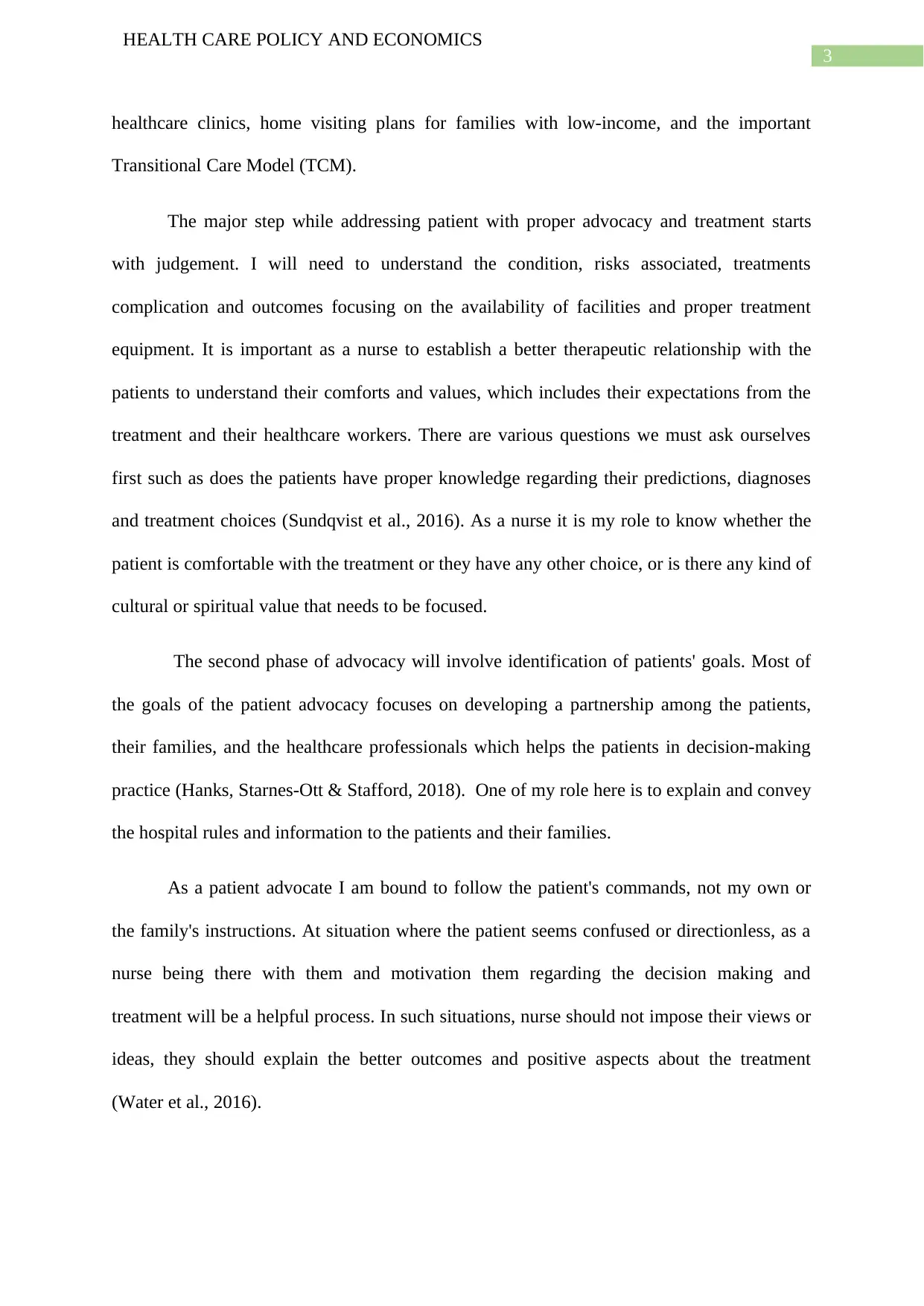
3
HEALTH CARE POLICY AND ECONOMICS
healthcare clinics, home visiting plans for families with low-income, and the important
Transitional Care Model (TCM).
The major step while addressing patient with proper advocacy and treatment starts
with judgement. I will need to understand the condition, risks associated, treatments
complication and outcomes focusing on the availability of facilities and proper treatment
equipment. It is important as a nurse to establish a better therapeutic relationship with the
patients to understand their comforts and values, which includes their expectations from the
treatment and their healthcare workers. There are various questions we must ask ourselves
first such as does the patients have proper knowledge regarding their predictions, diagnoses
and treatment choices (Sundqvist et al., 2016). As a nurse it is my role to know whether the
patient is comfortable with the treatment or they have any other choice, or is there any kind of
cultural or spiritual value that needs to be focused.
The second phase of advocacy will involve identification of patients' goals. Most of
the goals of the patient advocacy focuses on developing a partnership among the patients,
their families, and the healthcare professionals which helps the patients in decision-making
practice (Hanks, Starnes‐Ott & Stafford, 2018). One of my role here is to explain and convey
the hospital rules and information to the patients and their families.
As a patient advocate I am bound to follow the patient's commands, not my own or
the family's instructions. At situation where the patient seems confused or directionless, as a
nurse being there with them and motivation them regarding the decision making and
treatment will be a helpful process. In such situations, nurse should not impose their views or
ideas, they should explain the better outcomes and positive aspects about the treatment
(Water et al., 2016).
HEALTH CARE POLICY AND ECONOMICS
healthcare clinics, home visiting plans for families with low-income, and the important
Transitional Care Model (TCM).
The major step while addressing patient with proper advocacy and treatment starts
with judgement. I will need to understand the condition, risks associated, treatments
complication and outcomes focusing on the availability of facilities and proper treatment
equipment. It is important as a nurse to establish a better therapeutic relationship with the
patients to understand their comforts and values, which includes their expectations from the
treatment and their healthcare workers. There are various questions we must ask ourselves
first such as does the patients have proper knowledge regarding their predictions, diagnoses
and treatment choices (Sundqvist et al., 2016). As a nurse it is my role to know whether the
patient is comfortable with the treatment or they have any other choice, or is there any kind of
cultural or spiritual value that needs to be focused.
The second phase of advocacy will involve identification of patients' goals. Most of
the goals of the patient advocacy focuses on developing a partnership among the patients,
their families, and the healthcare professionals which helps the patients in decision-making
practice (Hanks, Starnes‐Ott & Stafford, 2018). One of my role here is to explain and convey
the hospital rules and information to the patients and their families.
As a patient advocate I am bound to follow the patient's commands, not my own or
the family's instructions. At situation where the patient seems confused or directionless, as a
nurse being there with them and motivation them regarding the decision making and
treatment will be a helpful process. In such situations, nurse should not impose their views or
ideas, they should explain the better outcomes and positive aspects about the treatment
(Water et al., 2016).
Paraphrase This Document
Need a fresh take? Get an instant paraphrase of this document with our AI Paraphraser
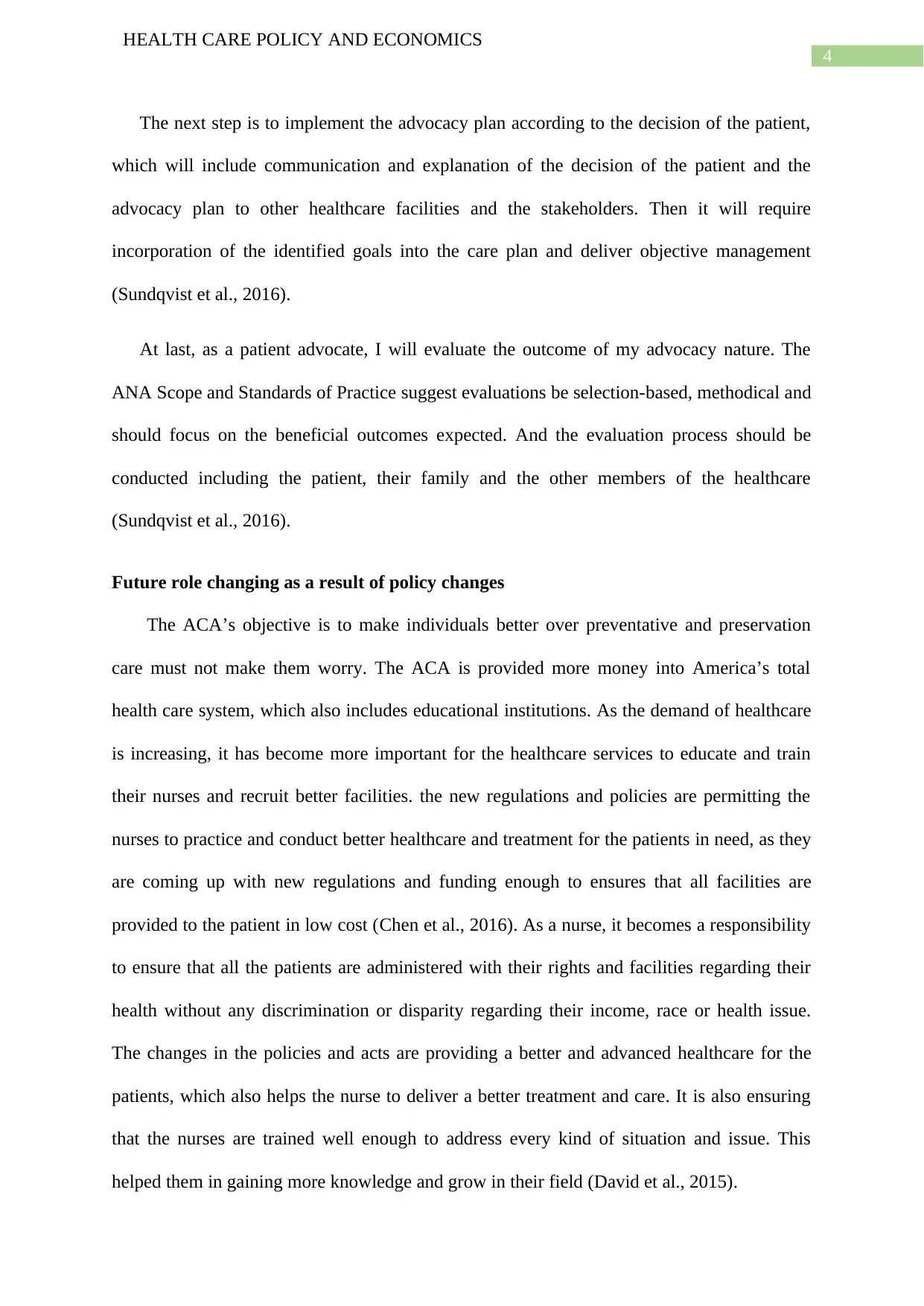
4
HEALTH CARE POLICY AND ECONOMICS
The next step is to implement the advocacy plan according to the decision of the patient,
which will include communication and explanation of the decision of the patient and the
advocacy plan to other healthcare facilities and the stakeholders. Then it will require
incorporation of the identified goals into the care plan and deliver objective management
(Sundqvist et al., 2016).
At last, as a patient advocate, I will evaluate the outcome of my advocacy nature. The
ANA Scope and Standards of Practice suggest evaluations be selection-based, methodical and
should focus on the beneficial outcomes expected. And the evaluation process should be
conducted including the patient, their family and the other members of the healthcare
(Sundqvist et al., 2016).
Future role changing as a result of policy changes
The ACA’s objective is to make individuals better over preventative and preservation
care must not make them worry. The ACA is provided more money into America’s total
health care system, which also includes educational institutions. As the demand of healthcare
is increasing, it has become more important for the healthcare services to educate and train
their nurses and recruit better facilities. the new regulations and policies are permitting the
nurses to practice and conduct better healthcare and treatment for the patients in need, as they
are coming up with new regulations and funding enough to ensures that all facilities are
provided to the patient in low cost (Chen et al., 2016). As a nurse, it becomes a responsibility
to ensure that all the patients are administered with their rights and facilities regarding their
health without any discrimination or disparity regarding their income, race or health issue.
The changes in the policies and acts are providing a better and advanced healthcare for the
patients, which also helps the nurse to deliver a better treatment and care. It is also ensuring
that the nurses are trained well enough to address every kind of situation and issue. This
helped them in gaining more knowledge and grow in their field (David et al., 2015).
HEALTH CARE POLICY AND ECONOMICS
The next step is to implement the advocacy plan according to the decision of the patient,
which will include communication and explanation of the decision of the patient and the
advocacy plan to other healthcare facilities and the stakeholders. Then it will require
incorporation of the identified goals into the care plan and deliver objective management
(Sundqvist et al., 2016).
At last, as a patient advocate, I will evaluate the outcome of my advocacy nature. The
ANA Scope and Standards of Practice suggest evaluations be selection-based, methodical and
should focus on the beneficial outcomes expected. And the evaluation process should be
conducted including the patient, their family and the other members of the healthcare
(Sundqvist et al., 2016).
Future role changing as a result of policy changes
The ACA’s objective is to make individuals better over preventative and preservation
care must not make them worry. The ACA is provided more money into America’s total
health care system, which also includes educational institutions. As the demand of healthcare
is increasing, it has become more important for the healthcare services to educate and train
their nurses and recruit better facilities. the new regulations and policies are permitting the
nurses to practice and conduct better healthcare and treatment for the patients in need, as they
are coming up with new regulations and funding enough to ensures that all facilities are
provided to the patient in low cost (Chen et al., 2016). As a nurse, it becomes a responsibility
to ensure that all the patients are administered with their rights and facilities regarding their
health without any discrimination or disparity regarding their income, race or health issue.
The changes in the policies and acts are providing a better and advanced healthcare for the
patients, which also helps the nurse to deliver a better treatment and care. It is also ensuring
that the nurses are trained well enough to address every kind of situation and issue. This
helped them in gaining more knowledge and grow in their field (David et al., 2015).
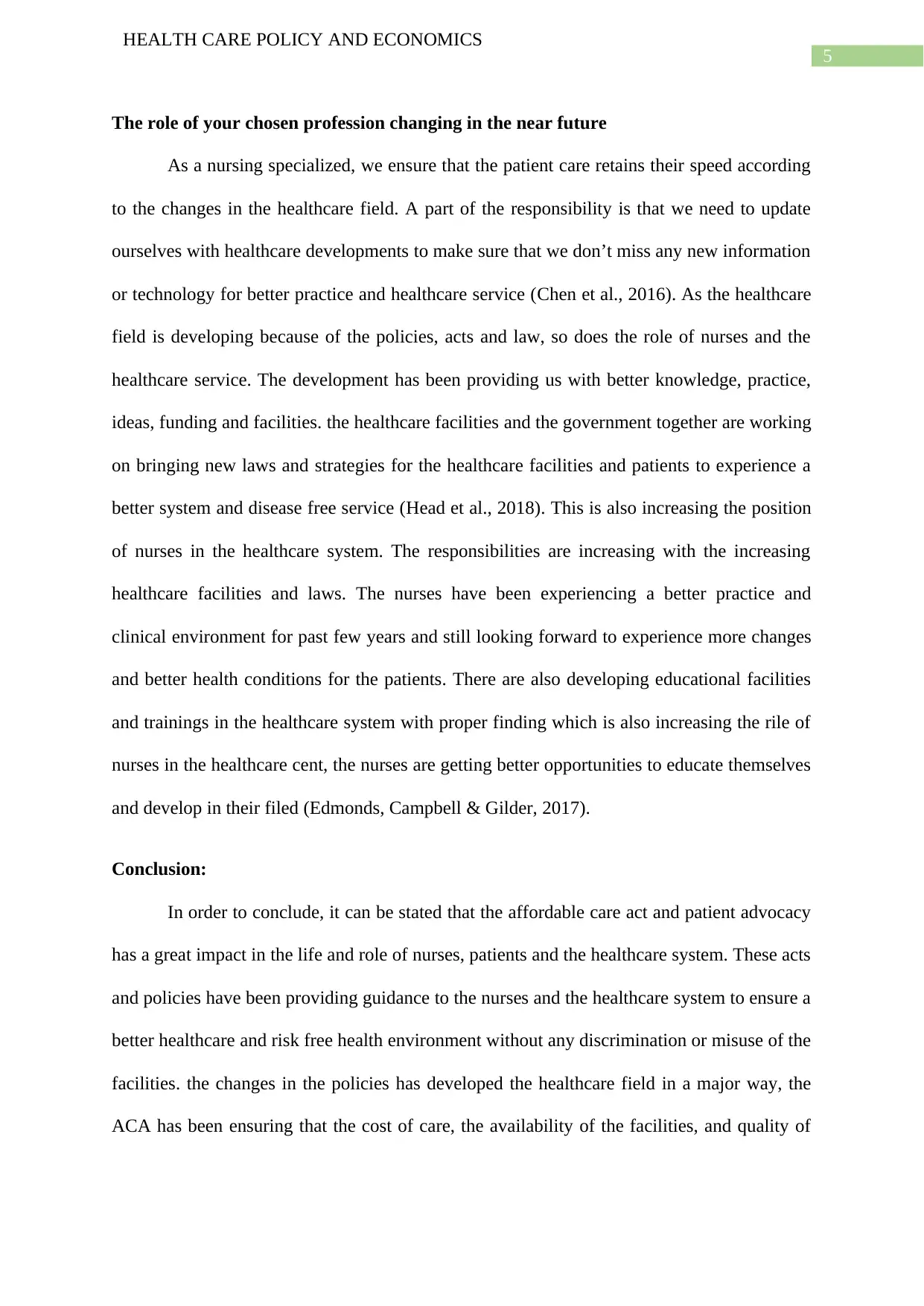
5
HEALTH CARE POLICY AND ECONOMICS
The role of your chosen profession changing in the near future
As a nursing specialized, we ensure that the patient care retains their speed according
to the changes in the healthcare field. A part of the responsibility is that we need to update
ourselves with healthcare developments to make sure that we don’t miss any new information
or technology for better practice and healthcare service (Chen et al., 2016). As the healthcare
field is developing because of the policies, acts and law, so does the role of nurses and the
healthcare service. The development has been providing us with better knowledge, practice,
ideas, funding and facilities. the healthcare facilities and the government together are working
on bringing new laws and strategies for the healthcare facilities and patients to experience a
better system and disease free service (Head et al., 2018). This is also increasing the position
of nurses in the healthcare system. The responsibilities are increasing with the increasing
healthcare facilities and laws. The nurses have been experiencing a better practice and
clinical environment for past few years and still looking forward to experience more changes
and better health conditions for the patients. There are also developing educational facilities
and trainings in the healthcare system with proper finding which is also increasing the rile of
nurses in the healthcare cent, the nurses are getting better opportunities to educate themselves
and develop in their filed (Edmonds, Campbell & Gilder, 2017).
Conclusion:
In order to conclude, it can be stated that the affordable care act and patient advocacy
has a great impact in the life and role of nurses, patients and the healthcare system. These acts
and policies have been providing guidance to the nurses and the healthcare system to ensure a
better healthcare and risk free health environment without any discrimination or misuse of the
facilities. the changes in the policies has developed the healthcare field in a major way, the
ACA has been ensuring that the cost of care, the availability of the facilities, and quality of
HEALTH CARE POLICY AND ECONOMICS
The role of your chosen profession changing in the near future
As a nursing specialized, we ensure that the patient care retains their speed according
to the changes in the healthcare field. A part of the responsibility is that we need to update
ourselves with healthcare developments to make sure that we don’t miss any new information
or technology for better practice and healthcare service (Chen et al., 2016). As the healthcare
field is developing because of the policies, acts and law, so does the role of nurses and the
healthcare service. The development has been providing us with better knowledge, practice,
ideas, funding and facilities. the healthcare facilities and the government together are working
on bringing new laws and strategies for the healthcare facilities and patients to experience a
better system and disease free service (Head et al., 2018). This is also increasing the position
of nurses in the healthcare system. The responsibilities are increasing with the increasing
healthcare facilities and laws. The nurses have been experiencing a better practice and
clinical environment for past few years and still looking forward to experience more changes
and better health conditions for the patients. There are also developing educational facilities
and trainings in the healthcare system with proper finding which is also increasing the rile of
nurses in the healthcare cent, the nurses are getting better opportunities to educate themselves
and develop in their filed (Edmonds, Campbell & Gilder, 2017).
Conclusion:
In order to conclude, it can be stated that the affordable care act and patient advocacy
has a great impact in the life and role of nurses, patients and the healthcare system. These acts
and policies have been providing guidance to the nurses and the healthcare system to ensure a
better healthcare and risk free health environment without any discrimination or misuse of the
facilities. the changes in the policies has developed the healthcare field in a major way, the
ACA has been ensuring that the cost of care, the availability of the facilities, and quality of
⊘ This is a preview!⊘
Do you want full access?
Subscribe today to unlock all pages.

Trusted by 1+ million students worldwide
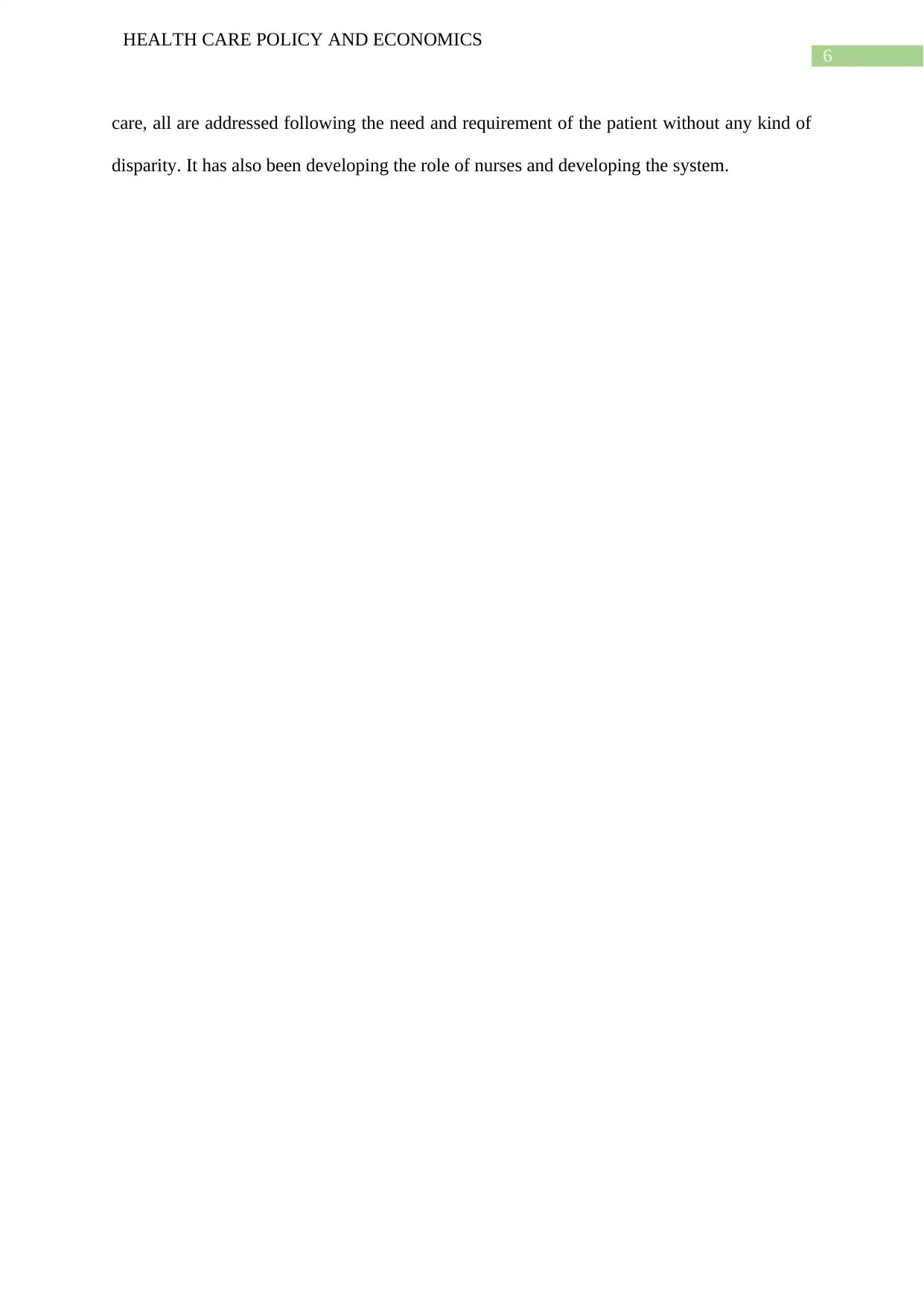
6
HEALTH CARE POLICY AND ECONOMICS
care, all are addressed following the need and requirement of the patient without any kind of
disparity. It has also been developing the role of nurses and developing the system.
HEALTH CARE POLICY AND ECONOMICS
care, all are addressed following the need and requirement of the patient without any kind of
disparity. It has also been developing the role of nurses and developing the system.
Paraphrase This Document
Need a fresh take? Get an instant paraphrase of this document with our AI Paraphraser
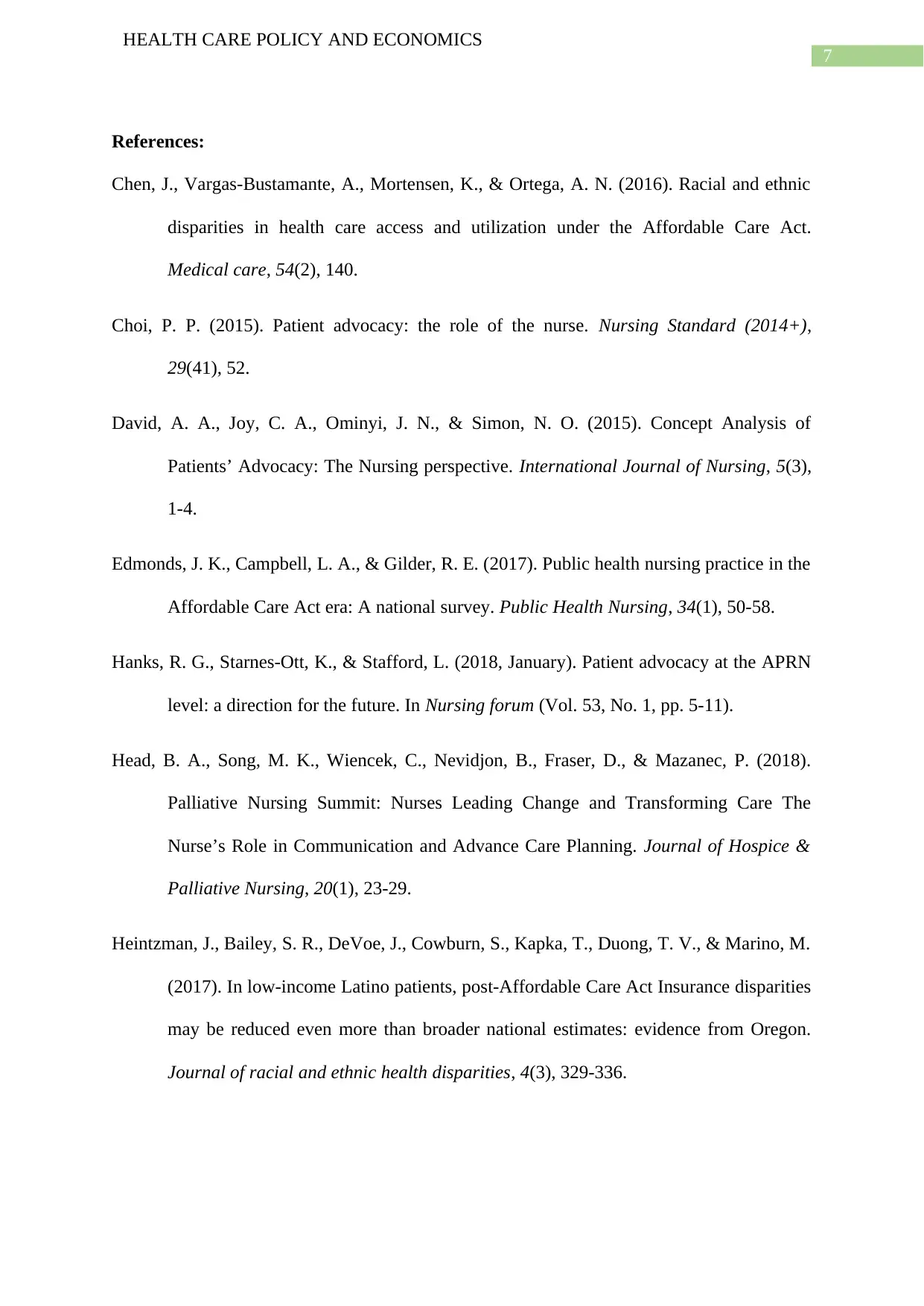
7
HEALTH CARE POLICY AND ECONOMICS
References:
Chen, J., Vargas-Bustamante, A., Mortensen, K., & Ortega, A. N. (2016). Racial and ethnic
disparities in health care access and utilization under the Affordable Care Act.
Medical care, 54(2), 140.
Choi, P. P. (2015). Patient advocacy: the role of the nurse. Nursing Standard (2014+),
29(41), 52.
David, A. A., Joy, C. A., Ominyi, J. N., & Simon, N. O. (2015). Concept Analysis of
Patients’ Advocacy: The Nursing perspective. International Journal of Nursing, 5(3),
1-4.
Edmonds, J. K., Campbell, L. A., & Gilder, R. E. (2017). Public health nursing practice in the
Affordable Care Act era: A national survey. Public Health Nursing, 34(1), 50-58.
Hanks, R. G., Starnes‐Ott, K., & Stafford, L. (2018, January). Patient advocacy at the APRN
level: a direction for the future. In Nursing forum (Vol. 53, No. 1, pp. 5-11).
Head, B. A., Song, M. K., Wiencek, C., Nevidjon, B., Fraser, D., & Mazanec, P. (2018).
Palliative Nursing Summit: Nurses Leading Change and Transforming Care The
Nurse’s Role in Communication and Advance Care Planning. Journal of Hospice &
Palliative Nursing, 20(1), 23-29.
Heintzman, J., Bailey, S. R., DeVoe, J., Cowburn, S., Kapka, T., Duong, T. V., & Marino, M.
(2017). In low-income Latino patients, post-Affordable Care Act Insurance disparities
may be reduced even more than broader national estimates: evidence from Oregon.
Journal of racial and ethnic health disparities, 4(3), 329-336.
HEALTH CARE POLICY AND ECONOMICS
References:
Chen, J., Vargas-Bustamante, A., Mortensen, K., & Ortega, A. N. (2016). Racial and ethnic
disparities in health care access and utilization under the Affordable Care Act.
Medical care, 54(2), 140.
Choi, P. P. (2015). Patient advocacy: the role of the nurse. Nursing Standard (2014+),
29(41), 52.
David, A. A., Joy, C. A., Ominyi, J. N., & Simon, N. O. (2015). Concept Analysis of
Patients’ Advocacy: The Nursing perspective. International Journal of Nursing, 5(3),
1-4.
Edmonds, J. K., Campbell, L. A., & Gilder, R. E. (2017). Public health nursing practice in the
Affordable Care Act era: A national survey. Public Health Nursing, 34(1), 50-58.
Hanks, R. G., Starnes‐Ott, K., & Stafford, L. (2018, January). Patient advocacy at the APRN
level: a direction for the future. In Nursing forum (Vol. 53, No. 1, pp. 5-11).
Head, B. A., Song, M. K., Wiencek, C., Nevidjon, B., Fraser, D., & Mazanec, P. (2018).
Palliative Nursing Summit: Nurses Leading Change and Transforming Care The
Nurse’s Role in Communication and Advance Care Planning. Journal of Hospice &
Palliative Nursing, 20(1), 23-29.
Heintzman, J., Bailey, S. R., DeVoe, J., Cowburn, S., Kapka, T., Duong, T. V., & Marino, M.
(2017). In low-income Latino patients, post-Affordable Care Act Insurance disparities
may be reduced even more than broader national estimates: evidence from Oregon.
Journal of racial and ethnic health disparities, 4(3), 329-336.
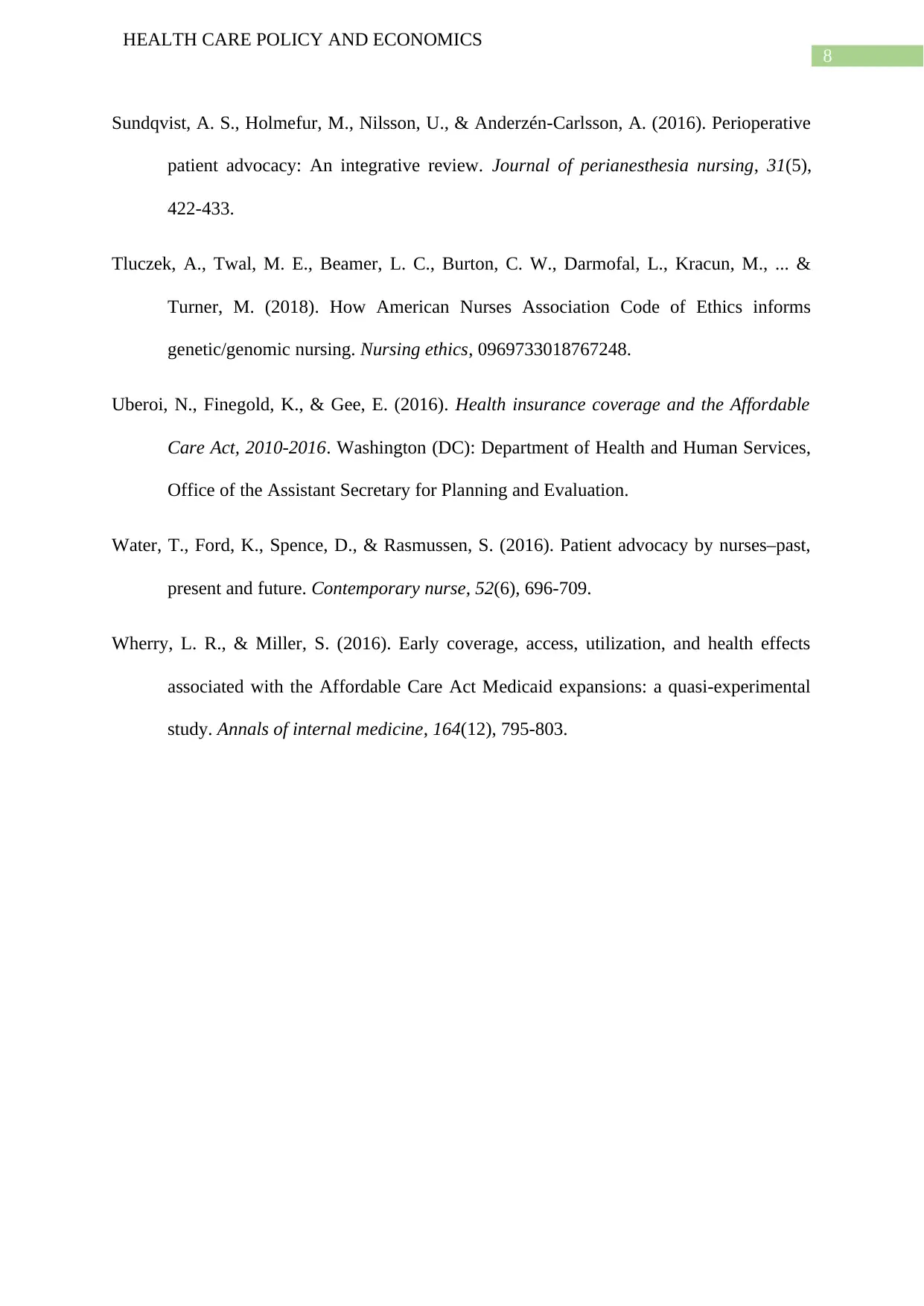
8
HEALTH CARE POLICY AND ECONOMICS
Sundqvist, A. S., Holmefur, M., Nilsson, U., & Anderzén-Carlsson, A. (2016). Perioperative
patient advocacy: An integrative review. Journal of perianesthesia nursing, 31(5),
422-433.
Tluczek, A., Twal, M. E., Beamer, L. C., Burton, C. W., Darmofal, L., Kracun, M., ... &
Turner, M. (2018). How American Nurses Association Code of Ethics informs
genetic/genomic nursing. Nursing ethics, 0969733018767248.
Uberoi, N., Finegold, K., & Gee, E. (2016). Health insurance coverage and the Affordable
Care Act, 2010-2016. Washington (DC): Department of Health and Human Services,
Office of the Assistant Secretary for Planning and Evaluation.
Water, T., Ford, K., Spence, D., & Rasmussen, S. (2016). Patient advocacy by nurses–past,
present and future. Contemporary nurse, 52(6), 696-709.
Wherry, L. R., & Miller, S. (2016). Early coverage, access, utilization, and health effects
associated with the Affordable Care Act Medicaid expansions: a quasi-experimental
study. Annals of internal medicine, 164(12), 795-803.
HEALTH CARE POLICY AND ECONOMICS
Sundqvist, A. S., Holmefur, M., Nilsson, U., & Anderzén-Carlsson, A. (2016). Perioperative
patient advocacy: An integrative review. Journal of perianesthesia nursing, 31(5),
422-433.
Tluczek, A., Twal, M. E., Beamer, L. C., Burton, C. W., Darmofal, L., Kracun, M., ... &
Turner, M. (2018). How American Nurses Association Code of Ethics informs
genetic/genomic nursing. Nursing ethics, 0969733018767248.
Uberoi, N., Finegold, K., & Gee, E. (2016). Health insurance coverage and the Affordable
Care Act, 2010-2016. Washington (DC): Department of Health and Human Services,
Office of the Assistant Secretary for Planning and Evaluation.
Water, T., Ford, K., Spence, D., & Rasmussen, S. (2016). Patient advocacy by nurses–past,
present and future. Contemporary nurse, 52(6), 696-709.
Wherry, L. R., & Miller, S. (2016). Early coverage, access, utilization, and health effects
associated with the Affordable Care Act Medicaid expansions: a quasi-experimental
study. Annals of internal medicine, 164(12), 795-803.
⊘ This is a preview!⊘
Do you want full access?
Subscribe today to unlock all pages.

Trusted by 1+ million students worldwide
1 out of 9
Related Documents
Your All-in-One AI-Powered Toolkit for Academic Success.
+13062052269
info@desklib.com
Available 24*7 on WhatsApp / Email
![[object Object]](/_next/static/media/star-bottom.7253800d.svg)
Unlock your academic potential
Copyright © 2020–2025 A2Z Services. All Rights Reserved. Developed and managed by ZUCOL.





